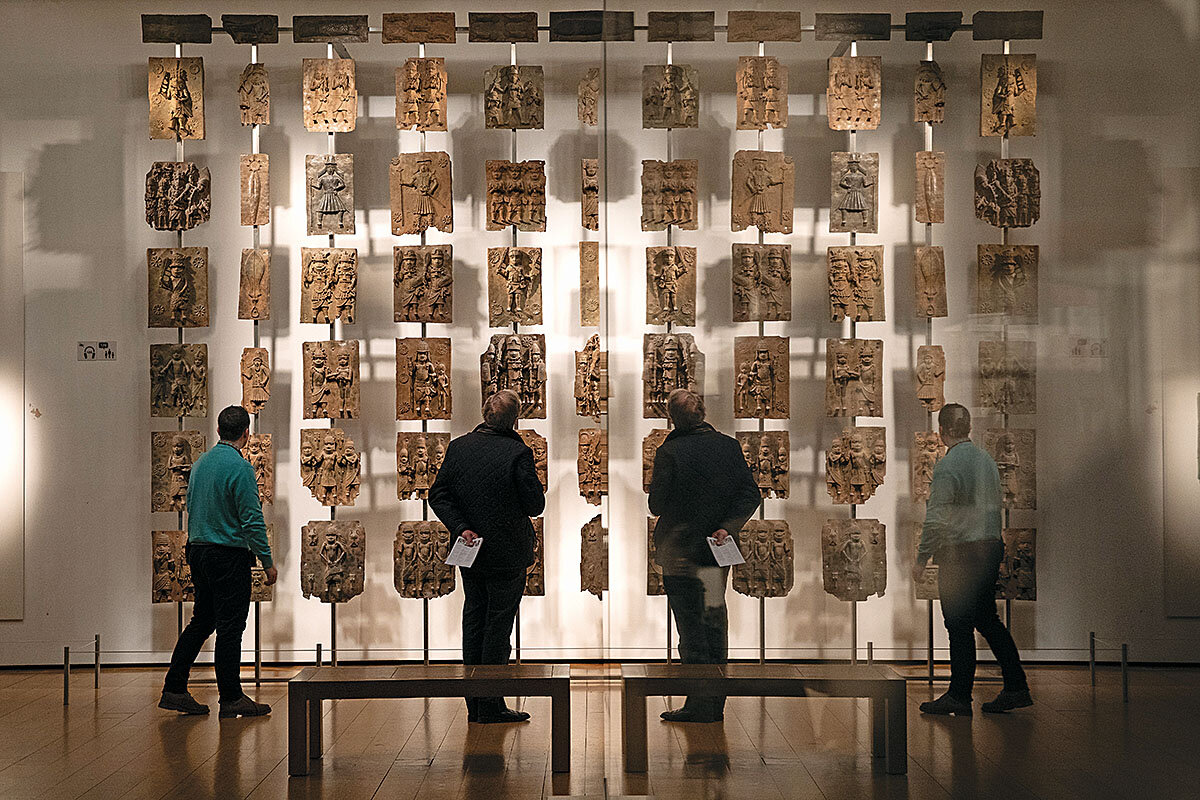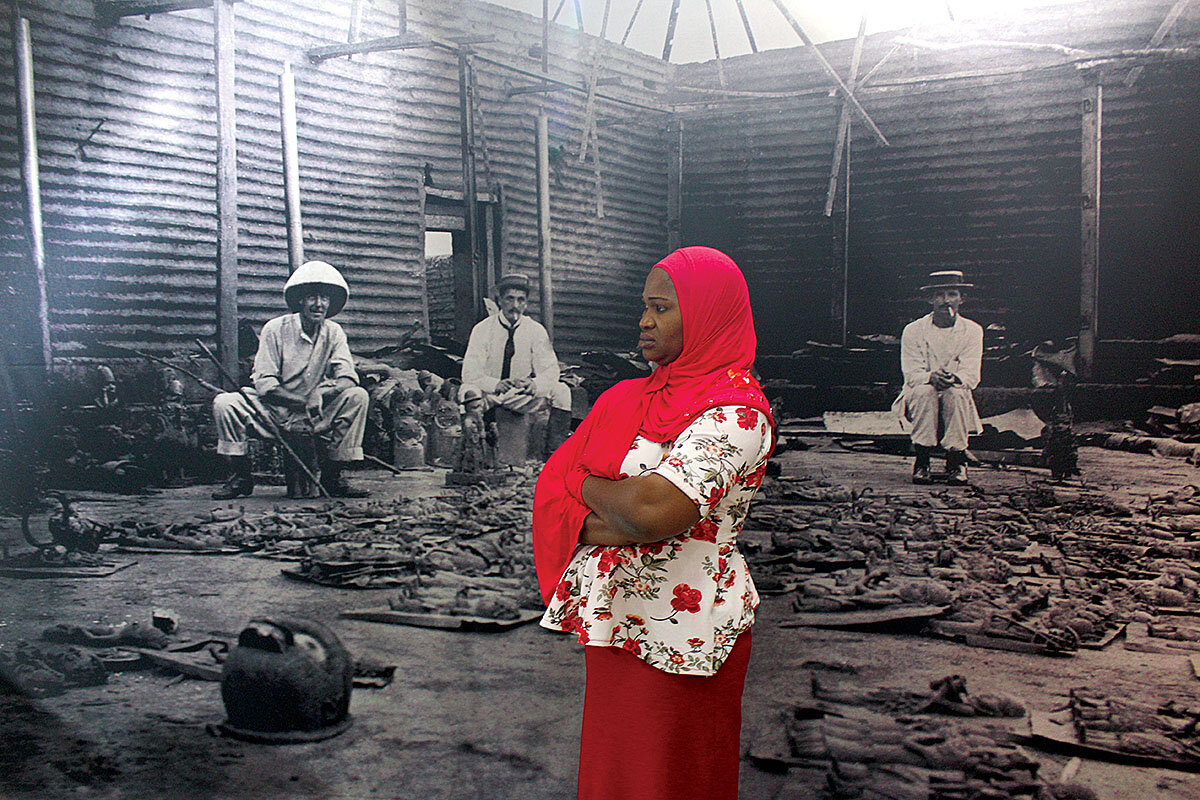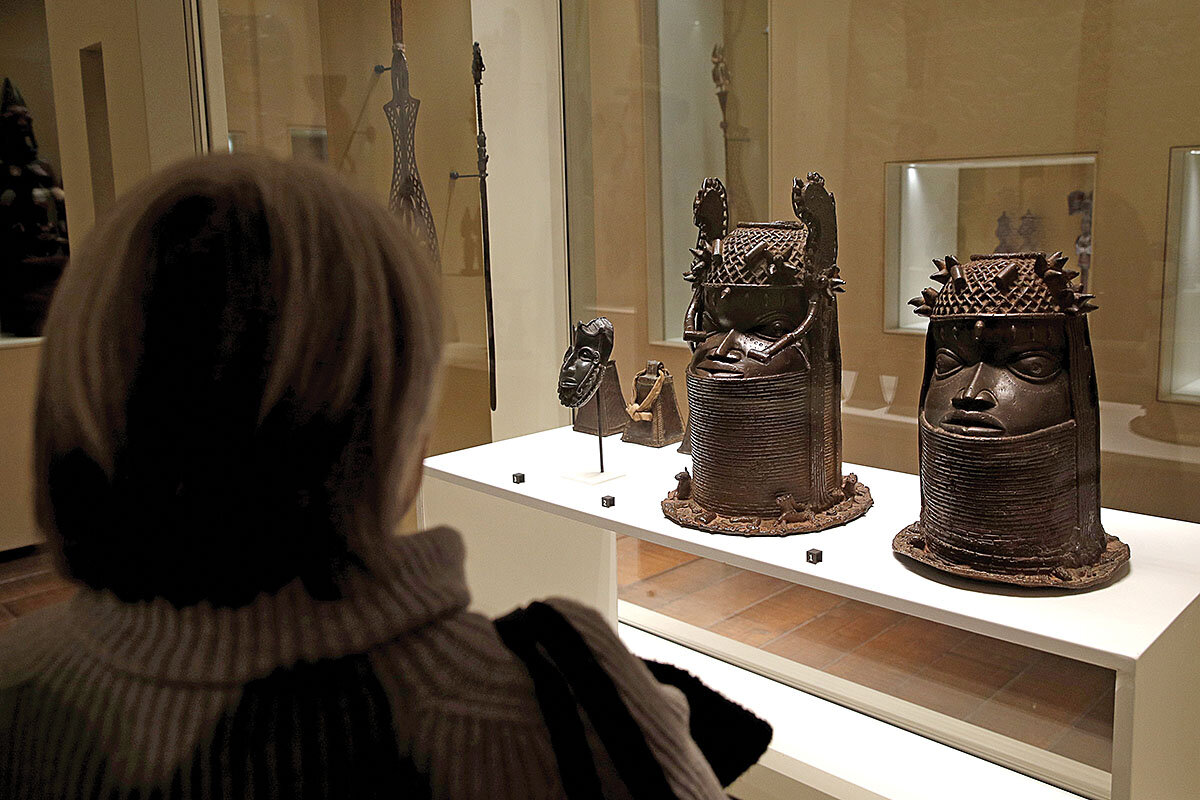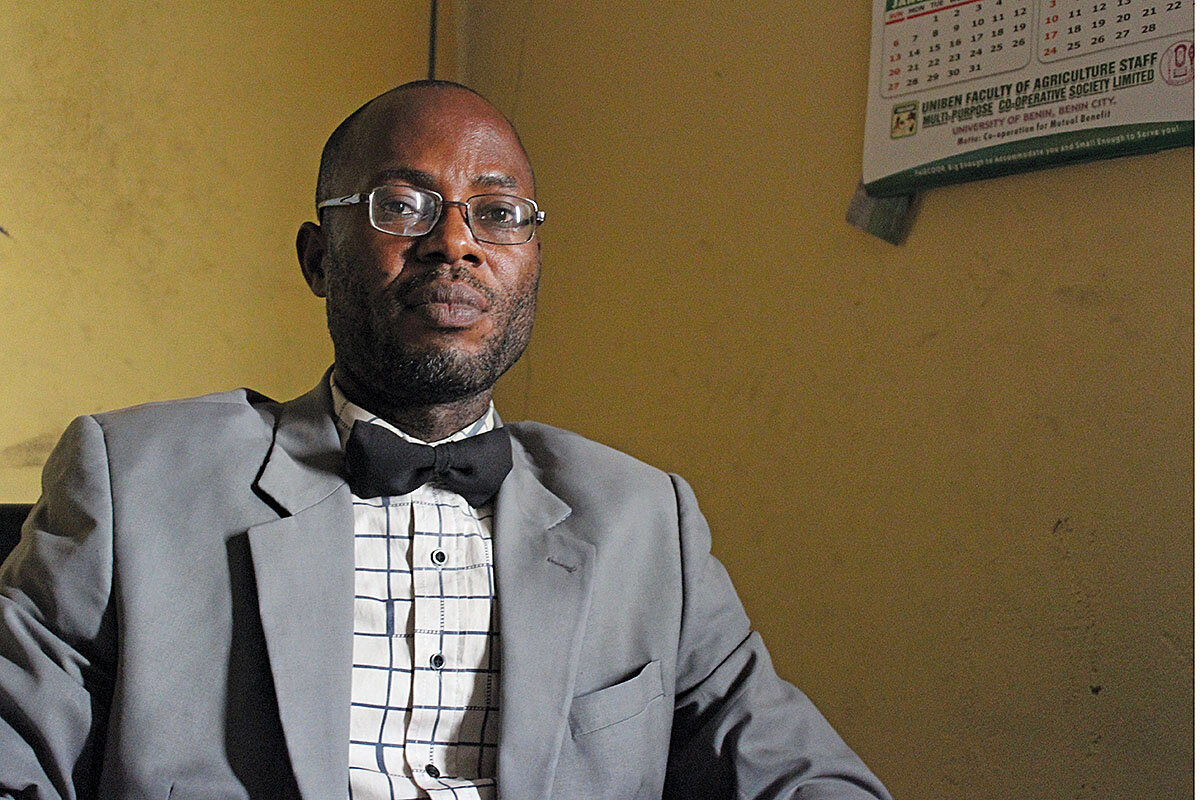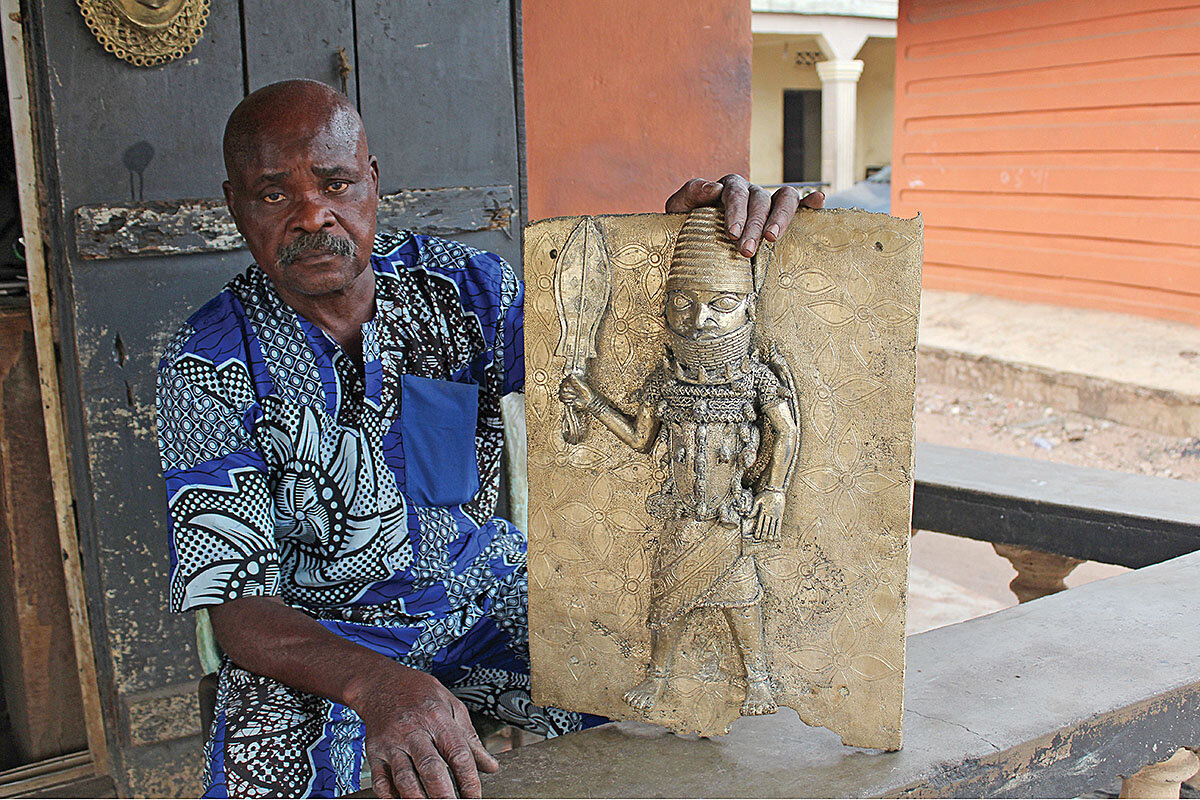Art of the steal: European museums wrestle with returning African art
Loading...
| London and Benin City, Nigeria
A dozen teenagers in matching burgundy school uniforms crane their necks toward a floor-to-ceiling display inside the National Museum here in Benin City.
“Does anyone know what this is?” asks Abigail Zaks-Ali. The tour guide doesn’t turn around as she begins to explain the photograph behind her. She doesn’t have to. She knows this story by heart.
The photo shows three white men sitting on stools, decked out in the white linen uniform of the 19th-century colonial explorer in Africa. Two have cigarettes dangling cavalierly from their lips. The third, his pith helmet casting a shadow over his face, is beaming. In front of them, scattered like old toys, are dozens of metal relief sculptures. More statues are jumbled behind them in haphazard piles.
Why We Wrote This
The debate about repatriating African art involves issues that go beyond museum doors: identity, ownership – and coming to terms with the past. What should justice for long-ago looting look like in today’s world?
“Those are our artifacts you see,” Ms. Zaks-Ali says. “These men took them to London and then sold them for a very low price.” The students nod in recognition. They have grown up with this story: the story of the British soldiers who arrived here in 1897, promising to negotiate; the story of the white men who instead torched the kingdom of Benin and carried away thousands of its precious artworks to pay for their expedition.
“You see how these men are smiling?” Ms. Zaks-Ali asks, finally turning to face the photograph. “They’re proud of what they took from us.”
A continent away, in the British Museum in London, dozens of reliefs like those in the photo are suspended in rows from floor to ceiling. The room is dark, and spotlights illuminate the rust-colored plaques and intricately crafted figures protruding from them. A few people wander through the room. One young woman takes a selfie in front of the reliefs. Few stop to read the text on a panel beside them, which explains how the works were looted. It is titled “The Discovery of Benin Art by the West.”
When a report commissioned by French President Emmanuel Macron recommended late last year that the French government begin returning African art taken during the colonial period, it injected a sense of urgency into an enduring debate engulfing much of the museum world: Who should be the caretaker of Africa’s cultural heritage – the Africans who created it, or the Europeans in whose museums it has long been displayed?
It’s a debate that has been happening in various forms since the era of African independence five decades ago. And perhaps nowhere has it played out more prominently than in the case of the famous Benin bronzes, plundered in 1897 and eventually scattered to museums and private collections across Europe. More than any other set of artworks, the bronzes made African art visible to Europeans, igniting widespread interest by scholars, artists, and the public. But in Nigeria and elsewhere in Africa, they have also become a kind of shorthand for colonialism’s violent reign – and its lingering influences.
“These bronzes are more than art,” says Ikhuehi Omonkhua, the chief exhibition officer of the National Museum in Benin City. “Keeping them abroad is like holding our ancestors hostage.”
But now, some of the bronzes may be on their way home – temporarily. Since 2010, museum curators from Europe and officials from Nigeria have been working quietly on plans to return the items, on loan, to the city from which they were taken more than a century ago.
The story of the bronzes may be – depending on whom you ask – either a road map or a cautionary tale on what the great former colonial powers should do with their appropriated treasures. It illustrates not only the complicated practical questions raised by repatriation, but deeply moral ones about how societies deal with the violence in their past.
When European explorers arrived at the coast of what is now southwest Nigeria in the 15th century, they found an eager trading partner in the wealthy African Kingdom of Benin. The kingdom (not to be confused with the modern-day country of Benin) was soon trading slaves and goods such as palm oil, rubber, and ivory for guns and other European commodities.
That give-and-take relationship held steady until the late 19th century, when London began pushing to incorporate the territory into the fledgling British Empire. At the time, the kingdom’s oba, a hereditary king, was Ovonramwen Nogbaisi, and his palace was the administrative and religious heart of the monarchy. The kingdom’s highly skilled artisans produced thousands of metal and ivory plaques and sculptures depicting people and events to adorn the palace and for use in ancestral altars. Though the metal pieces are usually referred to as bronzes, they were largely made from brass.
To the British, the oba was a perpetual irritation, obstinately refusing to recognize their flimsy control of the region. And so in December 1896, British Consul General James Robert Phillips led a small expedition to the oba’s palace. The purpose, he claimed, was to talk trade with the monarch. But in reality, he intended to overthrow him. “I have reason to hope that sufficient Ivory may be found in the King’s house to pay the expenses in removing the King from his Stool,” Phillips had written to the British Foreign Office the year before.
Historical accounts of what happened next – and why – differ, but one thing is clear: Soldiers from the Benin Kingdom attacked the British party, killing eight soldiers.
In retaliation, the British stormed the kingdom with thunderous force. In February 1897, their troops burned large swaths of Benin. They forced the oba into exile and shipped much of his wealth – nearly 3,000 brass and ivory figures that had been his personal possessions – to London.
There, some artifacts were given to the British Museum, while hundreds more went up for auction. Of those, some ended up in private hands, but most found their way into museums in Germany and other European countries, as well as the United States.
In Benin, the theft of the bronzes became a symbol of everything Nigerians lost to British colonialism, a story passed from generation to generation like a parable. “We grew up knowing that our people were massacred and our art was stolen,” says Kingsley Inneh, head of the bronze-casters guild in Benin City. “It was something that was lodged in our memories from a very young age.”
Meanwhile, Nigeria had its own museums to think about. In the aftermath of the country’s brutal civil war with the breakaway Republic of Biafra in the 1960s, Nigerian authorities poured money into the development of cultural institutions, hoping they could do something independence had not: unify the country.
“This museum and many others were built to show us that our history was shared,” says Mr. Omonkhua, of the museum in Benin City. But a lot of that history wasn’t there. While the museum in Benin did have a few bronzes, its collection was paltry in comparison to what was on display in Europe. The two largest collections are in the British Museum, which holds around 900 pieces from Benin, and the Ethnological Museum in Berlin, soon to be part of the Humboldt Forum, which possesses around 530 pieces.
And as Nigeria plunged into economic free fall in the late 1980s, its museums became a target for art thieves. The most infamous break-in came in 1994, when robbers stole artifacts worth about $200 million. For curators like Mr. Omonkhua, who had spent their careers evangelizing about the value of museums, the losses were devastating. Even worse, he says, is the way they became a symbol of Nigeria’s carelessness with its own history. If Nigerians couldn’t protect the contents of their museums, the argument went, why should European institutions entrust them with more objects?
The first time Abdulkerim Oshioke Kadiri visited the British Museum, in 2008, the acting director general of Nigeria’s National Commission for Museums and Monuments was astounded. Even though he had toured dozens of museums in Nigeria, he had never seen so many Benin bronzes in one place. “I saw how my people were being appreciated” by the world, he remembers. “I was amazed at how well [the bronzes] were cared for and displayed.”
But his pride was quickly stifled by another emotion: loss. “The naked fact is that these were stolen from us,” he says. “They shouldn’t be here. They didn’t arrive freely.” Most Nigerians, he knew, would never have the resources to stand where he did, in a museum in London, and look at their own history.
Western curators have long deployed a range of arguments to keep it that way: that countries of origin don’t have the museum infrastructure required to keep the artifacts safe, to adequately care for them, or to offer access to the public. That it is not always clear to whom the artifacts should be given – the people they were taken from or the nation-state that exists now? That the public interest served by eminent museums, and how they help people understand the world, outweighs the claims to restitution.
Chris Spring, who was curator of the Africa galleries at the British Museum until last year, says it would be positive to see loans of royal Benin works to Nigeria and possibly returns of certain pieces. “But in this day and age, in this multicultural society, a total repatriation of all those objects would almost be an act of vandalism in its own right,” he says. “It would be depriving so many millions of people of the knowledge of those extraordinary histories.”
For Nicholas Thomas, director and curator of the Museum of Archaeology and Anthropology in Cambridge, the question is a complicated one. In his office at the museum, which holds around 168 objects likely taken during the 1897 expedition, he acknowledges that arguments about conservation can sound like excuses to avoid restitution. “But it isn’t just an excuse,” he says. “There are plenty of cases where, despite the dedication of local museum staff, they don’t have the resources to manage material in the way that they would like.”
The Benin bronzes also illustrate how the ownership of artifacts can get complicated. The reliefs and sculptures were the personal property of the oba when they were stolen – so many might consider his descendant and current oba, Ewuare II, the rightful owner. But because the place they were taken from is now part of the state of Nigeria, the government there also claims them. Neither of the two museums in Europe with the largest collections of Benin bronzes has received an official request for restitution of the objects; one European curator suggested a disagreement over who they belong to could be part of the reason.
Even when returns are requested, the decision in some cases is not up to the museums at all: The British Museum Act of 1963 prohibits an institution from disposing of objects in its collection except in very limited circumstances, meaning any effort to repatriate objects would require government action. Similarly, French law considers the collections of national museums “inalienable,” prohibiting their removal. Other museums and countries have different legal frameworks and processes for dealing with their treasures.
To Jürgen Zimmerer, a history professor at the University of Hamburg who studies colonialism, all of these concerns are irrelevant, because the issue is not a practical one but a moral one. “The question is, do you keep objects which are stolen, or not?” If the answer is no, then there is nothing to do but return them, he says. “The idea that only Europe can keep objects safe is at the core of the colonial ideology, of the colonial gaze. We acquired these museums by looting, subjugating, even killing other people, and it requires a complete decolonization of our museum landscape or our knowledge landscape and people are refusing to do that.”
That means, he says, objects should return home even if the museums they are returning to aren’t as grand as the ones they are leaving behind. The National Museum in Benin City, for instance, has only three small galleries, and they are subject to the whims of a mercurial electrical grid. But the museum’s humble exhibits are carefully tended, and its staff brim excitedly with facts and figures as they shuttle tour groups through the round building.
“It’s a paradox, isn’t it?” says Mr. Omonkhua. “They don’t see us as intelligent enough to take care of our own history. They said we were monkeys, that we were not smart enough, and yet they valued the art produced by these monkeys and put it in their best museums.”
In 2007, Barbara Plankensteiner, then the curator of the Weltmuseum Wien, the museum of ethnology in Vienna, organized a monumental exhibition on the Kingdom of Benin that brought together hundreds of stunning artifacts. Three years later, she facilitated a dialogue with the goal of finding a way to make those treasures accessible to people in Nigeria, as well.
The effort, which became known as the Benin Dialogue Group, brought curators of European museums that hold collections of Benin works together with members of the Benin royal court, Nigerian museum curators, Nigerian government officials, and officials of Nigeria’s Edo State. From the outset, it was clear the group would not address the ownership of the bronzes. Instead, it would seek to bring them back to Nigeria through loans.
The progress was slow. By 2015, participating museums had still not signed a “memorandum of understanding” introduced two years earlier. Finally, last year, the group settled on a solution that managed to overcome the myriad hurdles: It announced plans to build a new museum in Benin City and fill it with some of the most iconic artifacts from the Benin Kingdom, from both European and Nigerian museums.
The Benin Royal Museum will be developed by Edo State and the royal court, with the support of the Nigerian National Commission for Museums and Monuments. European museums have pledged to contribute artifacts from their collections of Benin bronzes, on a rotating basis. The museum is scheduled to open in 2021.
The decision was celebrated in Europe, with headlines proclaiming the return of the looted treasures. But to some Nigerians, it felt a little like a slap in the face. “You can’t loan someone something that you stole,” says Emmanuel Inneh, a bronze caster in Benin City.
Officials are more circumspect. “We are anxious that our people should have access to their history in whatever way,” says Prince Gregory Akenzua, a member of the royal court and dialogue group. “We haven’t surrendered our demand for restitution. But we will participate in any effort to make these objects available to our people.”
Others see getting the art on loan as better than having nothing in their display cases at all. “You have to be realistic,” says Folarin Shyllon, a professor of law at the University of Ibadan and a member of the dialogue group. “Half a loaf,” he says, “is better than no loaf at all.”
European curators view the loans as the beginning, not the end. “I think we all understand in the group that it’s a minimum, and it’s a first step,” says Jonathan Fine, curator for the collections from West Africa at the Ethnological Museum in Berlin and a dialogue participant.
Just a few months after the group’s announcement, developments in France undermined the idea that loaning looted art back to the countries it was stolen from was an appropriate way to deal with the past. After declaring in 2017 that he wanted to see the “temporary or definitive restitution of African cultural heritage to Africa,” President Macron commissioned a report to plot a road map for doing so. In December the authors, Senegalese economist Felwine Sarr and French historian Bénédicte Savoy, recommended that France immediately begin repatriating objects obtained without consent during colonial rule, if countries ask for them back. They dismissed the idea of long-term loans. Perhaps most shockingly, they proposed turning around the burden of proof: Instead of demanding countries prove the objects were stolen, France should have to prove they were not stolen if it wants to keep them, they said.
That pushes the debate into radical new territory. While it is widely acknowledged that the Benin bronzes were looted, there is disagreement or uncertainty over thousands of other objects in European museums. Professor Zimmerer, who is a member of a committee coming up with new guidelines for German museums, says the change is necessary. “A colonial context is a context of injustice,” he says. The imbalance of power, he notes, was so pervasive that even transactions that seemed fair may not have been. “Not every object is stolen, not every object is acquired illegally, but the assumption is that a majority of them are, and this should be the starting point of our deliberations.”
Curators reject the idea that most of the objects in their museums were acquired unfairly. “The debate has unfortunately generated a sense that these collections are really only about one thing and that is colonial appropriation,” says Mr. Thomas. “Whereas I think the collections have incredibly complex stories, and there is a lot of the material that reached museums in Europe through local agency, through indigenous agency.” He cites as examples objects that were diplomatic gifts or the “historical equivalents of today’s tourist souvenirs.” And he says that contrary to widespread perceptions, many museum curators do want to grapple with colonial history and work toward collaborative solutions.
No one expects the French report to lead to the emptying out of museums across Europe. Even those who advocate restitution don’t want to see all African art returned. Professor Zimmerer points out that many museums could return large numbers of artifacts without even affecting their galleries: The British Museum displays just over 100 of the 900 Benin objects it has. The Berlin Ethnological Museum displays about 50 percent of its Benin artifacts.
In the meantime, people in Benin City are hardly waiting around for their history to be returned. Down the road from the oba’s palace, wedged between mechanics’ garages, dental clinics, and used clothing stores, are the workshops of the city’s current generation of bronze casters. More than 100 men work along this narrow stretch of Igun Street, meticulously casting and recasting scenes from Benin’s history. It is a process that has changed little over the centuries.
“We are the journalists of Benin,” says Mr. Inneh, the head of the bronze-casters guild, a hereditary organization that has long been the only supplier of statues to the monarchy here. “Before writing, this was the way we recorded events.” Important people and events in the history of the kingdom are cast again and again, as a way of preserving history.
“All we are saying is that these are ours,” says Mr. Inneh. “They were taken by force and now we want them back.”





